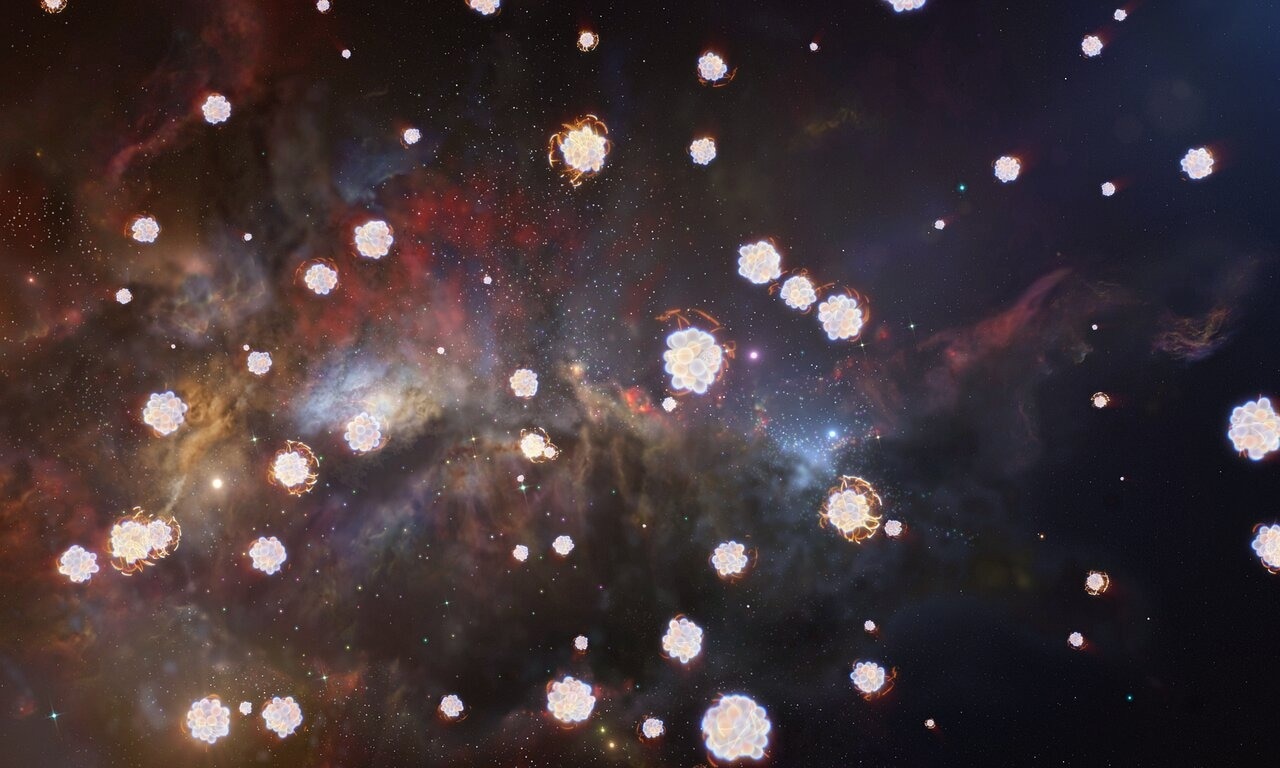For the first time, utilizing ESO’s Very Large Telescope (VLT), scientists have discovered the fingerprints left by the explosion of the first stars in the Universe.

Chemical elements in a distant gas cloud. Image Credit: European Southern Observatory
Three distant gas clouds were detected whose chemical composition equals what one expects from the first stellar explosions. Such findings take a step further in understanding the nature of the first stars that formed following the Big Bang.
For the first time ever, we were able to identify the chemical traces of the explosions of the first stars in very distant gas clouds.
Andrea Saccardi, Ph.D. Student, Observatoire de Paris–PSL
Saccardi headed this study at the time of his master’s thesis at the University of Florence.
Scientists think that the first stars that developed in the Universe were quite different from the ones that are seen at present. When they showed up 13.5 billion years ago, they contained just helium and hydrogen, the simplest chemical elements present in nature.
These stars are thought to have been tens or hundreds of times bigger than the Sun and rapidly died in strong explosions called supernovae. This enriches the encircling gas with bulkier elements. Later generations of stars came into being from the enriched gas and, in return, ejected bulkier elements as they also died.
The very first stars are now long gone, so how can scientists learn more about them?
Primordial stars can be studied indirectly by detecting the chemical elements they dispersed in their environment after their death.
Stefania Salvadori, Study Co-Author and Associate Professor, University of Florence
Salvadori is the co-author of the study reported today in the Astrophysical Journal.
By making use of the data taken with ESO’s VLT in Chile, the research group discovered three highly distant gas clouds observed when the Universe was just 10% to 15% of its present age and with a chemical fingerprint corresponding to what one can anticipate from the explosions of the first stars.
Based on the mass of such early stars and the energy of their explosions, these first supernovae released various chemical elements like oxygen, carbon, and magnesium, which are present in the exterior layers of stars.
However, few such explosions were highly energetic enough to eject bulkier elements like iron, which is discovered only in the cores of stars. To seek the tell-tale sign of these very first stars that blew up as low-energy supernovae, the team thus looked for gas clouds that were poor in iron but rich in the other elements.
They discovered just that: three faraway clouds present in the early Universe with a very little amount of iron but plenty of carbon and other elements—known to be the fingerprint of the explosions of the very first stars.
Also, this unusual chemical composition has been noted in several old stars in the Milky Way, which scientists consider to be second-generation stars that developed directly from the “ashes” of the first ones. This new study has discovered the fact that such ashes were in the early Universe, thus making an addition to a missing piece to this puzzle.
Our discovery opens new avenues to indirectly study the nature of the first stars, fully complementing studies of stars in our galaxy.
Stefania Salvadori, Study Co-Author and Associate Professor, University of Florence
To detect and study such distant gas clouds, the team utilized light beacons called quasars—very bright sources that have been powered by supermassive black holes at the centers of remote galaxies. Since the light from a quasar travel via the Universe, it passes through gas clouds where various chemical elements leave a mark on the light.
For such chemical imprints to be determined, the team examined data on various quasars noted with the X-shooter instrument on ESO’s VLT. X-shooter divides light into a broad wide range of wavelengths, or colors, which makes it a special instrument with which to determine several different chemical elements present in these distant clouds.
This study sets the stage for next-generation telescopes and instruments, like ESO’s upcoming Extremely Large Telescope (ELT) and its high-resolution ArmazoNes high Dispersion Echelle Spectrograph (ANDES).
“With ANDES at the ELT we will be able to study many of these rare gas clouds in greater detail, and we will be able to finally uncover the mysterious nature of the first stars,” concludes Valentina D’Odorico, a researcher at the National Institute of Astrophysics in Italy and co-author of the study.
Observing the ashes of the first stars | ESOcast Light
Using ESO’s Very Large Telescope, astronomers have found the fingerprints left by the explosions of the first stars. Video Credit: ESO
Journal Reference
Saccardi, A., et al. (2023) Evidence of First Stars-enriched Gas in High-redshift Absorbers. The Astrophysical Journal. doi.org/10.3847/1538-4357/acc39f